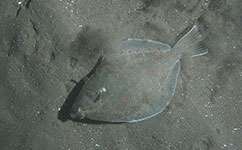Trawling makes for skinny flatfish

Trawling the seabed doesn't just remove some of the fishes living there; it also makes some of the survivors thinner and less healthy by forcing them to use more energy finding less nutritious food.
That's the conclusion of a new paper published in Proceedings of the Royal Society B, based on the work Dr Andrew Frederick Johnson undertook while studying for his PhD at Bangor University.
'We already knew that some species of bottom-dwelling fish in trawled areas were skinnier than those elsewhere, but until now it was assumed this was because they couldn't find enough food and went hungry,' he says.
Johnson's work sampling fish in the Irish Sea on Bangor University's research vessel Prince Madog shows that's not true; the stomachs of fish in trawled areas are as full as elsewhere, but they're full of different and less nutritious prey that the fish have to put more energy into finding. For instance, a fish with a bellyful of shellfish may feel full, but a lot of their meal is shell with no nutritional value. Much better to fill up on juicy worms - but these suffer more from the effects of trawling.
'It's not that the fish are hungry, exactly - it's that after trawling they are having to spend more energy finding prey that's much less energy-rich,' says Johnson, now at Scripps Institution of Oceanography, San Diego. A thinner fish with less energy in reserve will find it harder to cope with stressful situations or to invest in reproduction, which may have long-terms consequences for affected populations.
Trawling involves pulling a net along near the seabed, with chains attached that churn up the sediments and disturb bottom-dwelling fish so they swim up to be caught. It's a controversial fishing method that makes it much easier to catch fish that live on the sea floor. But at the same time it does serious damage to seabed ecosystems and can kill about a third of the invertebrates that live in the trawl path; recovery sometimes takes years. And this latest study shows the practice doesn't just affect flatfish directly by catching them; it also kills many of the small invertebrates they eat, so it indirectly affects the health of other fish in the area.
The effect varies from species to species. Johnson found that populations of bottom-dwelling flatfish with a specialised diet, like plaice, were more seriously affected, while there was no effect on generalist feeders like dab.
This means that if trawl fishing carries on with no restrictions or attempts to reduce its side-effects, in areas that are heavily trawled you'd expect the seabed to be increasingly dominated by generalists, at the expense of specialists. That matches what's happened fairly closely - plaice stocks struggled for many years, until trawling was reduced substantially, while dab remained plentiful whether in heavily or lightly trawled areas.
'Dab are better at catching energy-rich prey, so they can easily live in trawled areas, whereas plaice rely on a more specific diet so they have much more trouble adapting to changing prey environments,' Johnson says. 'This is the first time anyone's managed to use the feeding ecology of different fish species to explain the impact of trawling on their condition.' While the study looked only at these two species, its conclusions are likely to apply to any fish that spends all or some of its life on the seabed.
To ensure the sustainability of flatfish stocks, we may need new rules to make fishermen use less harmful gear, or trawl only over particular areas of the sea floor.
Johnson suggests that fishing boats could use new, innovative fishing gears that reduce the impact on seabed invertebrates. Trawlermen and women in the Netherlands and Belgium have been developing electrical trawls to replace the heavy chains, using electrical pulses to drive fish off the bottom and into the nets. Preliminary studies show that these trawls may have less of an effect on the food of flatfish, but more research is still needed.
He also says the introduction of 'trawling lanes' could help - this way, fishing boats would be allowed to trawl only in designated areas of ocean. This would confine trawl damage to the seabed to these areas, but the boats could still hope to catch fish there as they'd move in from neighbouring untouched areas. But he acknowledges that this kind of measure would be a challenge to enforce, and lanes would need to be chosen carefully in collaboration with fishers - if unproductive trawling lanes were selected, the approach could end up being counter-productive.
More information: Effects of bottom trawling on fish foraging and feeding (2014) Proceedings of the Royal Society B. Andrew Frederick Johnson, Giulia Gorelli, Stuart Rees Jenkins, Jan Geert Hiddink, Hilmar Hinz. DOI: 10.1098/rspb.2014.2336
This research was based on earlier by Dr Jan Geert Hiddink of Bangor University (2011) Journal of Applied Ecology - Could our fisheries be more productive? Indirect negative effects of bottom trawl fisheries on fish condition - DOI: 10.1111/j.1365-2664.2011.02036.x
Journal information: Proceedings of the Royal Society B , Journal of Applied Ecology
Provided by PlanetEarth Online
This story is republished courtesy of Planet Earth online, a free, companion website to the award-winning magazine Planet Earth published and funded by the Natural Environment Research Council (NERC).




















